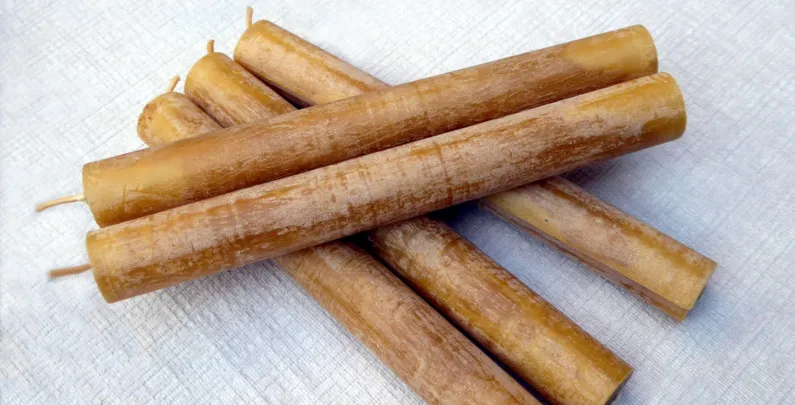In Part III, we looked into the preparation of the wick for making candles, and in parts IV, V, VI, VII, and VIII, we looked into the different waxes. In parts IX and X, we looked into the fragrance and colourant ingredients. Each of the materials and ingredients used play a role in the burning properties and health effects of the candle.
Once the wax has been chosen, melted, mixed with any fragrance and/or colour, and stirred thoroughly it is ready for the next step: moulding, pressing/extrusion, or dipping. (http://www.madehow.com/Volume-1/Candle.html).
Moulding
Moulding can be done by hand or by using manual or continuous moulding machines,. The continuous moulding machines are made to make candles in large groups. The exact process for preparing the moulds and wicks, and the method for pouring, depend on the type of candle and wax, and whether you are preparing the mould by hand or through a machine.
Clean moulds should be used to improve results. These moulds may be made from tin, aluminum, polyurethane, polycarbonate, rubber, silicone, latex, and more. Aluminum moulds are a popular choices because they leave a smooth finish without seams and are cheaper and easier to clean. However, they are not flexible and a releasing agent may be sprayed on the mould to help remove the candle. Certain waxes may shrink after heating and cooling. Some moulds, such as polyurethane, are flexible but have a strong odour. Glass containers are generally used for making container candles.
Moulds are usually preheated so that wax flows evenly and to allow for better side adhesion and to eliminate moisture or get rid of any “chill.” Only dry heat should be used and not hot water.
A wick is then introduced into the mould. The procedure used depends on the type of mould and candle being made. The wick may be pulled through a hole at the base of the mould and secured across the top. In a continuous moulding machine, the wick may be passed from a spool located beneath the machine. Another method uses a wick pin (a long metal pin that may come in a variety of diameters) to create a hole for the wick to be inserted in later.
The wax is cooled down to the lowest temperature possible, or slightly above its melting point, before it is poured into the mould. In the case of a moulding machine, the wax may be poured into a moulding table above the moulds, where it works its way down. If pouring by hand, make sure to poor slowly. The wax should reach just below the edge of the mould, though it does depend on the type of mould and style of candle. The wax is left to cool.
Many waxes naturally shrink or sink in, or concave, when cooling and a second pour may be needed. A jacket may be filled with cold water and placed around each mould to speed up the cooling process.
The temperature and humidity levels of the room all make a difference on the pour temperature and amount of preheating needed for the container or mould.
Once the candle has completely solidified, it can be removed. The removal process depends on the type of mould. Do not force the candle out, but gently work it out. You may have to tap the bottom of the mould and gently tug the wick pin, or you may grab the candle, and gently work it away from the mould. A hair dryer may also be used to soften the wax enough to help get it loose.
In a continuous moulding machine, the finished candle is pulled upwards out of the mould, which allows the wicks to thread through the moulds again for the next batch of candles.
The wicks are then trimmed to the correct size.
Pressing/Extrusion
Pressing involves compressing powdered or crushed paraffin wax into a candle shape with a press, which can include mechanical presses, hydraulic presses, or extruders.
Mechanical presses are used to make small-diameter candles with a pre-shaped wick hole, while hydraulic presses are used to make candles of various sizes with pre-inserted wick or a pre-shaped wick hole.
In extrusion, the wax and the wick are compressed in a pipe or cylindrical chamber under high pressure. The wax is then forced through a coned shaped exit, where the machine extrudes it as a long, continuous strand which is cut to specific sizes.
Hand Rolling
The candles may also be hand rolled or dipped. Hand rolled involving tightly rolling sheets of wax, such as in the case of rolled beeswax candles. These candles tend to trap more air, and thus burn faster.
Dipping
Dipping involves continuously dipping the prepared wick into melted wax until it adheres and achieves the desired thickness. Candles may also be dipped into clear or coloured lacquers to create a particularly shiny surface.
The finished candle may also be hand-painted and embellished with flower petals or other objects or accessories. Candle making is a science, but it is also a creative endeavour that involves constant experimentation. Even if you are not a candle maker, you can still enjoy looking into the techniques used in preparing these candles.
The aim of both candle maker and consumer should be the same on one factor: safety. Unless the candle has been made purely for decorative purposes and will not be lit, it should be constructed to provide a cleaner burn with minimal soot or smoking. The material should be non-toxic, eco-friendly, sustainable, and renewable.
In the next blog post in this series, we will go into some tips to keep in mind when selecting a candle as well as health and safety concerns.


Leave a Reply
You must be logged in to post a comment.